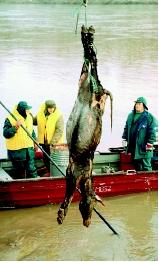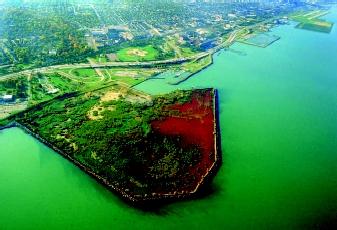Pollution of Lakes and Streams
Pollution is defined as "to make something impure"—in this case, the fresh water in lakes, streams, and groundwater . The pollution of water restricts its use for some human need or a natural function in the ecosystem .
Types of Pollutants
Physical.
Physical pollutants to lakes and streams include materials such as particles of soil that are eroded from the landscape or washed from paved areas by flowing water. Once in a lake or stream, some particles settle out of the water to become bottom sediments . Chemical pollutants adsorbed (bound) to the particles are also incorporated into the sediments, where they may be permanently buried, or be carried by the water currents to other locations.
Another type of physical pollutant is heat that may be discharged from an industrial source, or runoff from hot surfaces in warm weather. The overclearing of shade trees along the shoreline of a lake or stream may also permit sunlight to warm waters above the normal temperature range.
Chemical.
Fresh waters naturally contain chemicals dissolved from the soils and rocks over which they flow. The major inorganic elements include calcium, magnesium, sodium, potassium, carbon, chlorine, and sulfur as well as plant nutrients , such as nitrogen, silicon, and phosphorus. Organic compounds derived from decaying biological materials may also be present. In addition, nearly all fresh waters contain some human-made compounds, such as pesticides and other industrial and consumer products.
Chemicals resulting from human activities that increase the concentration of specific compounds above natural levels may cause pollution problems. Too much of a plant nutrient may lead to excessive plant growth, while synthetic organic compounds may cause physiological changes in aquatic organisms, or may become lethal at high concentrations. Pollutants can be taken up by plants and animals through contact with contaminated sediments, or directly from the water. Plants and organisms that become contaminated from these sources can pass the contamination up the food chain as predators consume them.
Biological.
Although living organisms themselves are not generally thought of as pollutants, bacteria and plants that grow to nuisance proportions

Point Sources of Pollution
Point sources of water pollution are defined as those that originate from a known point, such as a pipe from which a pollutant may enter a lake or stream.
Nearly every city, town, and waterside settlement discharges some type of pollution to surface waters . Human wastes that are collected in sewers and piped to municipal sewage treatment plants ultimately are discharged to surface waters as treated wastewater. Older systems with combined sewer and stormwater systems discharge untreated sewage to rivers or lakes during heavy rainfall that overwhelms the drainage system. But in general, treatment processes remove solid material, many of the chemical pollutants, and then disinfect the treated sewage to kill disease-causing organisms before releasing the treated wastewater to the receiving waterbody.
Almost every industry uses water in its manufacturing process or in the production of raw materials and energy. Water can pick up pollutants when it is used to make a product or clean a manufacturing area. The pretreatment of wastes prior to discharge to sewers or directly to surface waters can recover metals and other valuable chemicals that save companies money while reducing pollution.
Large volumes of water are drawn from rivers and streams to remove excess heat from industrial processes. Cooling water is passed over heat exchange surfaces that transfer heat to the water, which increases the water temperature. The electric power industry is the largest user of cooling water in steam-electric power plants. Although the cooling water itself is not boiled to steam, its temperature may rise several degrees. If the temperature exceeds regulatory limits, the water must pass through cooling ponds or towers that lower the temperature of the water before it is discharged.
Nonpoint Sources of Pollution
Nonpoint sources of water pollution are those that cannot be traced to a specific point, such as an outfall pipe. Nonpoint pollution flows and seeps untreated into lakes, streams, and groundwater from urban lawns and gardens, paved surfaces, construction sites, hillsides, agricultural fields, forests, and other land areas.
Urban.
In urban areas that have a high percentage of land covered by roofs, streets, and parking lots, rain and melting snow rapidly run off into lakes and rivers through drainageways and storm sewers. This urban runoff may contain nonpoint-source pollutants such as trash, pet wastes, lawn fertilizers, and herbicides, as well as oils, heavy metals , de-icing salts, and other pollutants from vehicles. In addition, the large volume of stormwater that rapidly enters streams from paved surfaces can produce flooding that erodes streambanks and destroys natural habitats.

Agriculture.
Modern agriculture depends on chemical fertilizers, pesticides, and irrigation to produce high-quality crops for animal and human consumption. To maximize the crop yield, nitrogen-based fertilizers are spread on the land. In addition, phosphorus and other essential minerals also may be applied where they are lacking or have been depleted in the soil. To improve production, herbicides to kill weeds and insecticides to kill insects are frequently applied to croplands. Not all of the fertilizers and pesticides stay where they are applied; consequently, some are released to the atmosphere, seep into groundwater, or are carried to lakes and streams by runoff, where they may create pollution problems.
Particles of soil that erode from tilled land can be carried by flowing water into lakes and streams. There, the fine particles fill the spaces between natural sand, gravel, and stones, thereby changing the surficial sediments comprising the benthic (bottom) habitat to a finer-grained silt and mud. Not only can bottom-dwellers be smothered by the fine particles, but sediment-water interactions can be changed.
Animal wastes create water pollution, such as when cattle or sheep are allowed to graze near streams. Wastes deposited by the animals can introduce nutrients and disease-causing organisms into the water, posing problems for aquatic organisms as well as human populations that use the water

Airborne.
Rain and snow are considered by some individuals to be relatively "pure," yet gases and particles introduced into the atmosphere by human activities and natural phenomena, such as volcanoes, can contaminate precipitation that falls back to Earth. The combustion of fossil fuels adds carbon dioxide to the atmosphere as well as nitrogen and sulfur compounds that tend to make precipitation more acidic. In areas of the world where the geology does not contain minerals that buffer the effects of the acids, the acidity of lakes and rivers may be increased as a result of "acid rain," derived, for example, from industrial areas. In addition, precipitation may also contain nutrients, heavy metals (e.g., mercury) and organic compounds that have entered the atmosphere and become entrained into precipitation.
Types of Impacts
Regardless of the type or source of a pollutant entering a lake or stream, the overall consequences to the environment may be the same—be it the degradation caused by soil erosion that eliminates the habitat of a stream organism, or the discharge of a chemical that interferes with a species' reproductive cycle. The use of water by humans can be compromised whether toxic chemical pollutants necessitate the treatment of drinking water, whether nutrients promote the growth of nuisance aquatic weeds that choke waterways, or whether bacteria close beaches.
The solution to water pollution is the elimination of pollutants at their source. This can be accomplished by reducing the use of polluting chemicals in the home and industry, by treating point sources to remove pollutants, and by each individual being more mindful of how human activities affect the landscape and the aquatic environment.
SEE ALSO Acid Rain ; Algal Blooms in Fresh Water ; Chemicals from Agriculture ; Ecology, Fresh-Water ; Erosion and Sedimentation ; Fish and Wildlife Issues ; Fresh Water, Natural Composition of ; Hydrologic Cycle ; Instream Water Issues ; Lake Health, Assessing ; Lake Management Issues ; Lakes: Biological Processes ; Lakes: Chemical Processes ; Lakes: Physical Processes ; Land Use and Water Quality ; Land-Use Planning ; Microbes in Lakes and Streams ; Nutrients in Lakes and Streams ; Pollution by Invasive Species ; Pollution of Streams by Garbage and Trash ; Pollution Sources: Point and Nonpoint ; Runoff, Factors Affecting ; Septic System Impacts ; Stream Ecology: Temperature Impacts on ; Stream Health, Assessing .
Arthur S. Brooks
Bibliography
Ball, Philip. Life's Matrix: A Biography of Water. New York: Farrar Straus and Giroux, 2000.
Dodds, Walter K. Freshwater Ecology, Concepts and Environmental Applications. San Diego, CA: Academic Press, 2002.
Gleick, Peter et al. The World's Water 2002–2003: The Biennial Report on Freshwater Resources. Washington, D.C.: Island Press, 2002.
Internet Resources
Water. U.S. Environmental Protection Agency. <http://www.epa.gov/ebtpages/water.html>
Water Resources of the United States. U.S. Geological Survey. <http://water.usgs.gov>